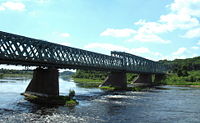
Railway Bridge, Kaunas
Encyclopedia

Kaunas
Kaunas is the second-largest city in Lithuania and has historically been a leading centre of Lithuanian economic, academic, and cultural life. Kaunas was the biggest city and the center of a powiat in Trakai Voivodeship of the Grand Duchy of Lithuania since 1413. During Russian Empire occupation...
crosses Nemunas river to connect Central Kaunas
Centras (Kaunas)
Centras is an elderate in the city of Kaunas, Lithuania, based on two neighbourhoods of Kaunas - the Old City and the New City. It lies at the confluence of two major Lithuanian rivers, the Nemunas and the Neris....
and lower Freda of Aleksotas
Aleksotas
Aleksotas is an elderate in the southern section of the city of Kaunas, Lithuania, bordering the left bank of the Neman River . Its population in 2006 was 21,694....
district. Because of its green paint, it is often called Green . Construction of the bridge started in 1859 and ended in 1862. The exploitation of the bridge started on the 4 February 1862. Together with central Kaunas Railway Station
Kaunas Railway Station
Kaunas Railway Station is a Lithuanian Railways central railway station at the eastern edge of central part of Kaunas, Lithuania. Kaunas Railway Station was included into the Registry of Immovable Cultural Heritage Sites of the Republic of Lithuania in 2003....
and Kaunas Railway Tunnel
Kaunas Railway Tunnel
Kaunas railway tunnel is one of the two tunnels existing in Lithuania and the only railway tunnel operating in the Baltic states. It connects Vilnius and Kaunas. The length of the tunnel is 1,285 metres , height – 6,6 metres, width – 8,8 metres...
, it forms an important Kaunas railway hub in Lithuania. However, during World War I
World War I
World War I , which was predominantly called the World War or the Great War from its occurrence until 1939, and the First World War or World War I thereafter, was a major war centred in Europe that began on 28 July 1914 and lasted until 11 November 1918...
parts of the bridge were destroyed, but soon afterwards were rebuilt as well as the standard gauge
Standard gauge
The standard gauge is a widely-used track gauge . Approximately 60% of the world's existing railway lines are built to this gauge...
was laid by Germans
Germans
The Germans are a Germanic ethnic group native to Central Europe. The English term Germans has referred to the German-speaking population of the Holy Roman Empire since the Late Middle Ages....
during the World War I
World War I
World War I , which was predominantly called the World War or the Great War from its occurrence until 1939, and the First World War or World War I thereafter, was a major war centred in Europe that began on 28 July 1914 and lasted until 11 November 1918...
. Paul von Hindenburg
Paul von Hindenburg
Paul Ludwig Hans Anton von Beneckendorff und von Hindenburg , known universally as Paul von Hindenburg was a Prussian-German field marshal, statesman, and politician, and served as the second President of Germany from 1925 to 1934....
was among the guests who participated in the opening ceremony of the reconstructed bridge. During World War II
World War II
World War II, or the Second World War , was a global conflict lasting from 1939 to 1945, involving most of the world's nations—including all of the great powers—eventually forming two opposing military alliances: the Allies and the Axis...
, the bridge was blown up several times, but was rebuilt later. Kaunas Railway Bridge was included into the Registry of Immovable Cultural Heritage Sites of the Republic of Lithuania in 1996.

